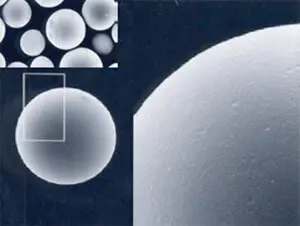Checkout using your account
Checkout as a new customer
Creating an account has many benefits:
- See order and shipping status
- Track order history
- Check out faster
Metal-oxide based Columns
Metal oxides as packing materials in HPLC columns open up innovative avenues in chromatographic separation science by offering unique selectivities and stabilities that cannot always be achieved with traditional silica or polymer-based columns. The most commonly used metal oxides include zirconia (ZrO2), alumina and titania (TiO2), which are characterised by their exceptional mechanical strength and chemical stability, especially at high pH and in strong solvents.
The robust physical properties of metal oxides also enable longer column life and high reproducibility of separations, even under demanding conditions. This makes them a valuable option for demanding analytical tasks where conventional materials may not be able to provide the required performance.
Basics
What are the advantages of metal oxide-based HPLC columns?
- Very high chemical stability - stable over almost the entire pH range
- Exceptional mechanical stability
- Highly thermally inert - can be used up to approx. 150 to 200 °C with suitable hardware
- Zirconium oxide and titanium oxide-based phases show higher stability compared to each other than aluminium oxide-based stationary phases
- No risk of shrinkage or swelling when changing temperature, ionic strength or solvent
1. Supelco
Supelco™ offers the Discovery® Zirconia series, a range of zirconium oxide-based HPLC columns.
Discovery®Zr-PS: Separation of hydrophobic compounds and amines
Discovery®Zr-PBD: Retention behaviour similar to C18-modified silica gel
Discovery®Zr-Carbon: Separation of geometric isomers and diastereomers
Discovery®Zr-CarbonC18: For universal use
- Separation of acids, bases and neutrals
- Completely different selectivity compared to C18 silica gel
Discovery® Zr-SAX:
- Separation of biomolecules, e.g. water-soluble vitamins, (oligo)nucleotides, nucleosides, amino acids or peptides
- Mixed mode separations with hydrophobic, Lewis acid - Lewis base and ion exchange interactions.
| Specification | Discovery® Zr-PS | Discovery® Zr-PBD | Discovery® Zr-Carbon | Discovery® Zr-CarbonC18 | Discovery® Zr-SAX |
| USP code |
| L49 |
|
|
|
| Phase | Cross-linked polystyrene | Cross-linked polybutadiene | Graphitic carbon | C18 modified carbon | Polyethyleneimine |
| Endcapping | No | No | No | No |
|
| Particle base | Zirconium oxide | Zirconium oxide | Zirconium oxide | Zirconium oxide | Zirconium oxide |
| Particle shape | Spherical | Spherical | Spherical | Spherical | Spherical |
| Particle size | 3 & 5 µm | 3 & 5 µm | 3 & 5 µm | 3 & 5 µm | 3 µm |
| Pore size | 300 Å | 300 Å | 300 Å | 300 Å | 300 Å |
| Spec. surface area | 30 m2/g | 30 m2/g | 30 m2/g | 30 m2/g | 30 m2/g |
| Packing density | 2.21 g/mL | 2.21 g/mL | 2.21 g/mL | 2.21 g/mL | N/A |
| Carbon content | 2% | 2% | 1% | 3% | 25% |
| Loading | N/A | N/A | N/A | 2.8 µmol/m2 | N/A |
| pH range | 1 to 13 | 1 to 13 | 1 to 14 | 1 to 14 | 1 to 12 |
| Temperature range | ≤ 100 °C[1] | ≤ 100 °C[1] | ≤ 100 °C[2] | ≤ 100 °C[2] | ≤ 80 °C |
[1] Special hardware is required for use between 100 °C and 150 °C, [2] Special hardware is required for use between 100 °C and 200 °C
2. Merck
Merck™ is the manufacturer of Aluspher® 100 RP-select B, which is based on aluminium oxide.
Developed for the separation of acids, bases and neutrals.
| Description | Properties |
| Particle base | Aluminium oxide |
| phase | Polybutadiene (PBD) |
| Particle shape | Spherical |
| Particle size | 5 µm |
| Pore size | 100 Å |
| Specific surface area | 170m2/g |
| pH range | 2 to 12 |
3. GL Sciences
GL-Sciences™ is the manufacturer of Titansphere® TiO, a titanium oxide (TiO2) based stationary phase
The spherical, unmodified TiO2 particles have a very smooth surface and ideal physical properties for chromatography. Titansphere® TiO phases have exceptional selectivity and strong retention properties for phosphorylated substances, making them particularly suitable for the purification of phosphopeptides and phosphorylated saccharides.

| Description | Properties |
| Particle size | 5 µm |
| Particle shape | Spherical |
| Specific surface area | 170 m2/g |
| Pore size | 100 Å |
| Max. Max. pressure | 19.8 MPa |
| pH range | 2 to 12 |
MZ-Analysentechnik GmbH gives you access to all metal oxide-based HPLC columns from the manufacturers Supelco™, Merck™ and GL-Sciences™. On the individual manufacturer pages you will find the entire manufacturer range with product filters for easy selection of products according to your requirements. We would be happy to provide you with a customised offer for your requirements!
No results were found for this filter combination. Please adjust your selection and try again.
The right column for you - we will be happy to support you individually
Competent consultants are always at your side. Write a message to our consultants, we will get back to you and give you individual support.
You will find:
Write us a message and we will get back to you as soon as possible.


![[English:] [English:]](https://cms.mz-at.de/fileadmin/_processed_/d/4/csm_logo_gl-sciences_web23_w600-h225px_b226085355.webp)